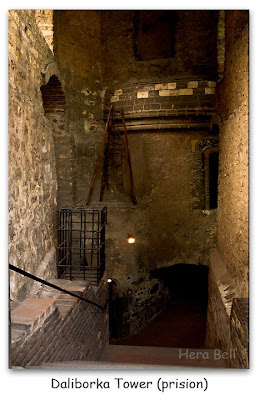Today we learned how to use the tram.

A couple of days ago, we did hike across to the Little Quarter and make our way up the hill to the Castle Quarter. But since today we wanted to enter the sites, we wanted to spend our time at the sites, and not tiring ourselves just to get to the first site.
Guide books mention that tram tickets can be bought at one's hotel reception desk and newstands. Since we were staying at a rented apartment, the first choice did not exist, so we tried the second option. We were fortunate that the newstand vendor spoke some broken English, but were disappointed that he did not sell any tram tickets. He did tell us that we could buy them at the Underground Metro, and since our tram stop was also a Metro stop, it did not force us out of our way.
A brief word about language. Everyone does speak Czeck, as well as some other Slavic languages. We forget, that not too long ago, this was part of the Soviet block, so other common second and third languages are Russian and German. English is really a new import, that only started with the collapse of the Soviet Union, and rarely spoken by those over the age of 40.
Walking down Wenceslas Square, we turned west onto another broad boulevard that led towards the Metro station and tram stop. Walking into the Metro, I noticed a sign in English stating "buy tickets" with an arrow pointing around the kiosk. As we walked around, the man at the kiosk was just leaving, locked the door, and raised his arms in a gesture of "sorry."
Fortunately below the sign, there was a vending like machine, with some English instructions. We read them over a few times, counted our coins, watched a few locals, and then tried our luck. With smiles on our face, our tickets appeared.
The trams run quite regularly, are quite efficient, and relatively inexpensive at 26 Kc (about $1.50). I wished Montreal had such inexpensive, and frequent service.
The tram ride itself followed a very similar route that we had walked just a couple of days before, going through the Little Quarter, and then up and behind the Castle Quarter, high on the hill.
Hera had her heart set on seeing the Monastery. A friend of hers had taken photographs with his tripod of the library at the Monastery. But we were disappointed as we approached, when we saw the sign that the Monastery was unexpectedly closed today. Tourists nearby said they heard that there was a movie being filmed there today.
We walked behind the Monastery to its garden, where we found a delightful panoramic view of the city.
We also found an interesting "Miniature Museum," where an artist created works of art that can only be viewed under a microscope or magnifying glass. Some items included a tiny lock and key on an ant's leg, and portraits drawn on half a poppy seed or grain of rice.
Back tracking a bit, we walked over to the Loreta Square. This small site holds the Santa Casa (Holy House), perhaps the Holiest site of the region. It supposedly contains part of the original house of the Mother Mary, and is where pilgrims would set out on their pilgrimage across Europe ending at Santiago de Compostela in Northwest Spain, basically the end of the known world.
Behind the Santa Casa, is a very pretty Baroque church. Unfortunatley, no photography is allowed at the Loreta Site.
Prague Castle complex is where the region had been governed for over a thousand years, since the time of St. Wencelas, who Christianized the area and is the symbol of Czech nationalism and statehood.
After getting our tickets and audioguide, we started with St. Vitus Cathedral. A huge Gothic Cathedral, that holds one of Europe's largest windows of this type. The tombs of many notables, Kings and Saints, are contained within this Cathedral including St. John of Nepomuk (whom I might write more about another day) as well as St. Wencelas himself. In St. Wencelas chapel, along with his tomb, is a small locked box holding the crown of St. Wencelas, locked with seven locks. The seven keys are held by different people of the church, the state and the city. St. Wencels crown is brought out rarely and very special occaissions.
The Old Royal Palace, contains a huge hall that was the largest hall without central supports in its time, with side apartments that hold their own stories and various political intrigues.

The nearby Golden Lane got its name from goldsmiths that refused to join the town Gold Smith Guild, and set up small shops below the Castle. Frank Kafka lived in one of these small houses for a year, as well as a clairevoyant who was killed by the Nazis because she erroneously predicted a short war.

At the end of the Golden Lane, we arrived at the Daliborka Tower. A prison tower, with its dungeon, holding various interesting devices to extract confessions. Amazing how things have not changed since these Medieval times, as we extract confessions from present dangers to the state at Guantanamo Bay.



We could have walked home, but were glad to take the tram. Once again, there was hardly a wait, as we found our Tram 22, and rode it home, for another good cold beer.
Cheers,
Hera & Anthony
No comments:
Post a Comment
Note: Only a member of this blog may post a comment.